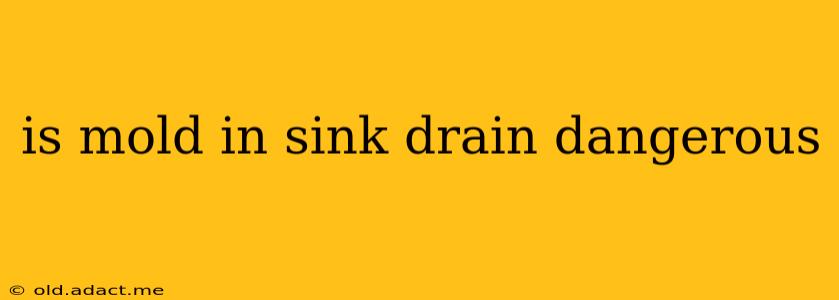Mold in your sink drain might seem like a minor inconvenience, but it's crucial to understand the potential health risks and how to address this common household problem. While not all mold is inherently dangerous, the presence of mold in a damp, dark environment like a drainpipe can pose several health concerns. This comprehensive guide will delve into the dangers, identification, prevention, and remediation of mold in sink drains.
What are the dangers of mold in a sink drain?
Mold thrives in moist, poorly ventilated areas, and sink drains often meet these criteria. The dangers primarily stem from the potential inhalation of mold spores. While most people experience no ill effects from exposure to low levels of mold, individuals with allergies, asthma, or compromised immune systems are particularly vulnerable. Exposure can trigger allergic reactions such as sneezing, coughing, itchy eyes, and skin rashes. In more severe cases, it can worsen asthma symptoms or even lead to serious respiratory infections. Certain types of mold can also produce mycotoxins, toxic substances that can cause more severe health problems. Therefore, addressing mold in your sink drain is not just about aesthetics but also about protecting your health.
Can mold in the sink drain make you sick?
Yes, mold in a sink drain can make you sick, although the severity depends on several factors, including the type of mold, the amount of exposure, and the individual's health status. As mentioned earlier, individuals with pre-existing respiratory conditions are at higher risk. The symptoms range from mild allergic reactions like runny nose and itchy eyes to more severe respiratory issues like difficulty breathing and coughing fits. It's essential to remember that not all molds are created equal; some are more allergenic or toxigenic than others. If you suspect you're experiencing health problems due to mold exposure, consult a healthcare professional immediately.
How do I know if I have mold in my sink drain?
Identifying mold in a sink drain can be challenging as it's often hidden from view. However, several signs can indicate its presence:
- A musty odor: A persistent, unpleasant smell emanating from the drain is a significant warning sign.
- Visible mold: If you can see a slimy, fuzzy, or discolored growth within the drain, it's almost certainly mold. This is easiest to spot in drains with clear or translucent pipes.
- Slow draining: A buildup of organic material can contribute to mold growth and also cause slow drainage.
- Recurring clogs: Frequent clogs might signal a build-up of mold and other debris in the drain.
How to get rid of mold in my sink drain?
Addressing mold in your sink drain requires a multi-pronged approach focusing on cleaning and prevention. Here's a step-by-step guide:
- Protection: Wear protective gear, including gloves, eye protection, and a mask, to avoid direct contact with mold.
- Boiling Water: Pour a kettle of boiling water down the drain. This can kill some mold spores and help dislodge debris.
- Baking Soda and Vinegar: Follow the boiling water with a mixture of baking soda and vinegar. The fizzing action helps to break down organic matter and neutralize odors.
- Commercial Drain Cleaner (Use with Caution): Many commercial drain cleaners are effective against mold, but use these with extreme caution and always follow the manufacturer's instructions. Ensure adequate ventilation and never mix different types of cleaners.
- Mechanical Cleaning: If the mold persists, you may need to use a drain snake or other tools to physically remove the mold and debris from the pipes. This might require specialized knowledge or professional help.
How to prevent mold in sink drains?
Prevention is key to avoiding mold in your sink drains. Here are some effective strategies:
- Regular Cleaning: Regularly clean your sink and drain with hot soapy water.
- Avoid standing water: Ensure that water doesn't accumulate in the sink or drain.
- Proper Ventilation: Maintain good ventilation in the bathroom to reduce moisture levels.
- Use a drain strainer: A strainer will catch food particles and hair, preventing them from accumulating and creating a breeding ground for mold.
What type of mold is most common in sink drains?
Several types of mold can grow in sink drains, but exact identification often requires laboratory analysis. Common types include Cladosporium, Penicillium, and Aspergillus. However, knowing the specific type is less crucial than addressing the mold itself, as any mold can pose health risks.
By following these preventative measures and taking swift action if you suspect mold growth, you can maintain a healthy and mold-free kitchen environment. Remember, if you're concerned about your health or unable to effectively eliminate the mold, it's always best to consult a professional plumber or mold remediation specialist.
